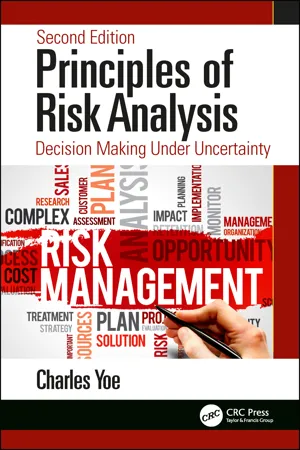
- 816 pages
- English
- ePUB (mobile friendly)
- Available on iOS & Android
About this book
In every decision problem there are things we know and things we do not know. Risk analysis science uses the best available evidence to assess what we know while it is carefully intentional in the way it addresses the importance of the things we do not know in the evaluation of decision choices and decision outcomes. The field of risk analysis science continues to expand and grow and the second edition of Principles of Risk Analysis: Decision Making Under Uncertainty responds to this evolution with several significant changes. The language has been updated and expanded throughout the text and the book features several new areas of expansion including five new chapters. The book's simple and straightforward style—based on the author's decades of experience as a risk analyst, trainer, and educator—strips away the mysterious aura that often accompanies risk analysis.
Features:
- Details the tasks of risk management, risk assessment, and risk communication in a straightforward, conceptual manner
- Provides sufficient detail to empower professionals in any discipline to become risk practitioners
- Expands the risk management emphasis with a new chapter to serve private industry and a growing public sector interest in the growing practice of enterprise risk management
- Describes dozens of quantitative and qualitative risk assessment tools in a new chapter
- Practical guidance and ideas for using risk science to improve decisions and their outcomes is found in a new chapter on decision making under uncertainty
- Practical methods for helping risk professionals to tell their risk story are the focus of a new chapter
- Features an expanded set of examples of the risk process that demonstrate the growing applications of risk analysis
As before, this book continues to appeal to professionals who want to learn and apply risk science in their own professions as well as students preparing for professional careers. This book remains a discipline free guide to the principles of risk analysis that is accessible to all interested practitioners.
Files used in the creation of this book and additional exercises as well as a free student version of Palisade Corporation's Decision Tools Suite software are available with the purchase of this book.
A less detailed introduction to the risk analysis science tasks of risk management, risk assessment, and risk communication is found in Primer of Risk Analysis: Decision Making Under Uncertainty, Second Edition, ISBN: 978-1-138-31228-9.
Frequently asked questions
- Essential is ideal for learners and professionals who enjoy exploring a wide range of subjects. Access the Essential Library with 800,000+ trusted titles and best-sellers across business, personal growth, and the humanities. Includes unlimited reading time and Standard Read Aloud voice.
- Complete: Perfect for advanced learners and researchers needing full, unrestricted access. Unlock 1.4M+ books across hundreds of subjects, including academic and specialized titles. The Complete Plan also includes advanced features like Premium Read Aloud and Research Assistant.
Please note we cannot support devices running on iOS 13 and Android 7 or earlier. Learn more about using the app.
Information
Risk = Consequence × Probability | (1.1) |
|---|
Table of contents
- Cover
- Half Title
- Title Page
- Copyright Page
- Dedication
- Contents
- Preface
- About the Author
- Chapter 1: The Basics
- Chapter 2: Uncertainty
- Chapter 3: Risk Management
- Chapter 4: Risk Assessment
- Chapter 5: Risk Communication
- Chapter 6: Enterprise Risk Management
- Chapter 7: Problem Identification for Risk Management
- Chapter 8: Brainstorming
- Chapter 9: Economics of Risk Management
- Chapter 10: Risk Assessor’s Toolbox
- Chapter 11: The Art and Practice of Risk Assessment Modeling
- Chapter 12: Probability Review
- Chapter 13: Choosing a Probability Distribution
- Chapter 14: Characterizing Uncertainty through Expert Elicitation
- Chapter 15: Monte Carlo Process
- Chapter 16: Probabilistic Scenario Analysis
- Chapter 17: Sensitivity Analysis
- Chapter 18: Presenting and Using Assessment Results
- Chapter 19: Decision Making Under Uncertainty
- Chapter 20: Message Development
- Chapter 21: Telling Your Story
- Chapter 22: Example Applications
- Appendix A: Using Palisade’s DecisionTools® Suite
- Index